To all my readers,
I will be having a 3 week break from publishing articles and information. I am moving house and I had to get the internet cut off because of that. I will also be starting my course in web and advertising design so will be organising things for that. As soon as I can I will return to publishing as normal.
Thanks for your patience :)
Friday, January 30, 2009
Temporary break from publishing
Wednesday, January 28, 2009
In the International Spotlight...Israel Cricket
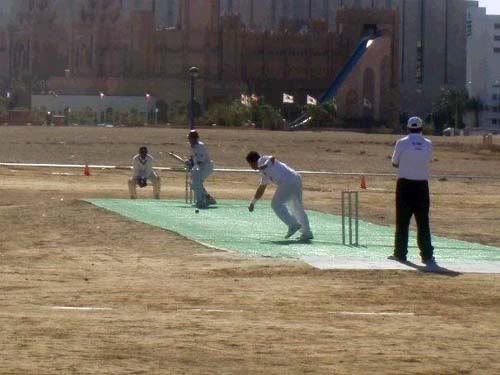
The Israel national cricket team is the team that represents the country of Israel in international cricket matches. Despite being geographically part of the Middle East, they are members of the European Cricket Council.
They regularly take part in the European Championship, and are currently ranked as the 12th best non-test team in Europe by the International Cricket Council, having been an associate member of that organisation since 1974.
Beginnings:
As is most often the case, cricket was introduced to Israel by the British. Local enthusiasts managed to keep the game going once the British had left in 1948, but the game was struggling until the mid 1960s, when an influx of Jewish immigrants from cricket playing countries revived the game, mainly South Africa, United Kingdom, and the sub-continent.
The first national league was formed in 1966, which lead the formation of the Israel Cricket Association (ICA) in 1968. The league prospered despite conditions ill-suited to cricket. Games were played on dusty, grass-less football fields, on matting wickets. However, the enthusiasm of the players has overcome these drawbacks.
ICC Membership:
Israel became an associate member of the ICC in 1974, with only Pakistan opposing their membership. Israel competed in the first ICC Trophy in 1979, failing to get past the first round. They also failed to progress beyond the first round in the 1982 tournament and 1986 tournament.
They reached the plate competition of the ICC Trophy in 1990 and 1994 and in 1996 competed in the first European Championship in Denmark, finishing eighth in the eight team tournament. The 1997 ICC Trophy in Malaysia gave them a brief, though unwanted, moment in the spotlight. Malaysia does not recognise the state of Israel, and they faced political demonstrations throughout the tournament from the Islamic Party of Malaysia. They were the first Israeli sports team to play in the country and finished in 21st place.
In 1998, they finished ninth in the European Championship ahead of only Gibraltar and the following year travelled to Gibraltar to take part in a quadrangular tournament also involving France and Italy, losing to France in the third place play-off.
21st Century:
Israel have been playing in Division Two of the European Championships since 2000, finishing fifth in 2000, fourth in 2002 and sixth in 2004. In the 2006 tournament, the Israeli team were again met with protests, due to the then ongoing crisis in the Middle East. Their first match, against Jersey was cancelled and their remaining two group games were met by protests. Their play-off games were then moved to RAF Lossiemouth to be played under armed guard. The second of these games, against Greece was forfeited by the Greeks, who had travel problems. Israel thus finished in seventh place.
In November 2007, Israel were defeated in a relegation match against Croatia, in the first international cricket game played in Israel. The loss meant that they were relegated from the 2nd European division, to the 3rd. Their next competition will be in 2009.
Links to more information on Israel Cricket:
*Acknowledgements to Wikipedia.org and owners of pictures and videos used.

Monday, January 26, 2009
English County Cricket Clubs: Gloucestershire
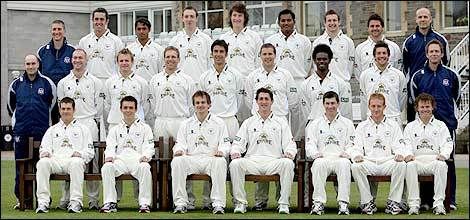
Gloucestershire County Cricket Club is one of the 18 major county clubs which make up the English domestic cricket structure, representing the historic county of Gloucestershire. Its limited overs team is called the Gloucestershire Gladiators.
The club plays most of its home games at the County Cricket Ground, Bristol. Currently, each season a number of games are played at both the Cheltenham and Gloucester cricket festivals held at the College Ground, Cheltenham and The King's School, Gloucester.
Records:
Batting:
Best Partnership for each wicket:
Bowling:
Earliest cricket:
Cricket probably reached Gloucestershire by the end of the 17th century. It is known that the related sport of "Stow-Ball" aka "Stob-Ball" was played in the county during the 16th century. In this game, the bat was called a "stave". See Alice B Gomme : The Traditional Games of England, Scotland and Ireland.
A game in Gloucester on 22 September 1729 is the earliest definite reference to cricket in the county. From then until the founding of the county club, very little has been found outside parish cricket.
Origin of club:
Records from 1863 have been found of an organisation in Cheltenham that is believed to have been the forerunner of Gloucestershire CCC, which had definitely been founded by 1871. Exact details of the club’s foundation have been lost.
The club played its initial first-class match versus Surrey at Durdham Down near Bristol on 2, 3 & 4 June 1870. Gloucestershire joined the (unofficial) County Championship at this time.
Club history:
The early history of Gloucestershire is dominated by the Grace family, most notably W G Grace. WG's father, Dr H M Grace, was involved with the formation of the club. It was a successful period with Gloucestershire winning three "Champion County" titles in the 1870s.
Since then Gloucestershire's fortunes have been mixed and they have never won the official County Championship. They struggled in the pre-war years of the County Championship because their best batsmen, apart from Gilbert Jessop and briefly Charlie Townsend, were very rarely available. The bowling, except when Townsend did sensational things on sticky wickets in late 1895 and late 1898, was very weak until George Dennett emerged - then it had the fault of depending far too much on him. Wally Hammond, who still holds many of the county's batting records formed part of an occasionally strong inter-war team, although the highest championship finish during this period was second in 1930 and 1931, when Charlie Parker and Tom Goddard formed a devastating spin attack.
Outstanding players since the war include Tom Graveney, "Jack" Russell and overseas players Mike Procter, Zaheer Abbas and Courtney Walsh.
Gloucestershire enjoyed a run of success in one-day cricket in the late 1990s and early 2000s. They won several titles mainly under the captaincy of Mark Alleyne whilst being coached by John Bracewell.
The club's captain for the 2006 season, Jon Lewis, became the first Gloucestershire player for nearly 10 years to play for England at Test Match level, when he was picked to represent his country in the Third Test against Sri Lanka at Trent Bridge in June 2006. His figures in the first innings were 3-68, including a wicket in his very first over in Test cricket, and he was widely praised for his debut performance.
Gloucestershire reached the final of the 2007 Twenty20 Cup, where they narrowly lost to Kent.
Links to more information on the Gloucestershire County Cricket Club:
*Acknowledgements to Wikipedia.org and owners of pictures and videos used.

Sunday, January 25, 2009
Player Profile(#49)...Shaun Tait (Australia)

Shaun William Tait (born 22 February 1983 in Bedford Park, Adelaide, South Australia) is a professional Australian cricketer. Tait plays domestic cricket for South Australia and is also a representative for Australia at Test, One Day International and Twenty20 International level. He is a right arm fast bowler.
Bowling style:
Tait's delivery action is unique and marked by significant lateral twisting of the spine. The 'slingy' nature of his action has led to comparisons with former Australian fast bowler Jeff Thomson. Dubbed "The Wild Thing", Tait is considered one of the fastest bowlers in the world and delivers the ball with phenomenal speed, at around 150km/h, and occasionally faster. One delivery was measured at 160km/h in an One Day International on 4 February 2007 against New Zealand. Despite his speed, Tait has often been described as "erratic" and is capable of bowling many extras. His unpredictability, however, is seen as a weapon to some, and his exceptional strike rate seems to confirm this. Tait has also been criticised as "expensive", however others have mentioned that this is irrelevant, as his main role as a "strike bowler" is to take wickets rather than keep the run rate down.
After a Twenty20 match against New Zealand on 11 December 2007, in which Tait troubled the batsmen and took 2/22, New Zealand captain Daniel Vettori and coach John Bracewell publicly raised doubts over the legality of Tait's bowling action. Tait labelled the comments as a "disgrace" and added that he'd be willing to undergo tests to prove his action is legal. Only two days after Vettori made them, he was dismissed by Tait in the opening match of the Chappell-Hadlee Trophy.
Domestic career:
Tait has represented South Australia for a majority of his first-class career, however has also played matches for Australia A and Durham. He has taken over 150 first-class wickets at a strike rate of under 50.
At the age of nineteen, Tait made his first-class debut for South Australia against Western Australia on 19 December 2002 at the Adelaide Oval. He only bowled in one innings on his debut, yet finished with respectable figures of 3/77 off 22.2 overs. Tait played 5 games in his first season, taking 20 wickets at an average of 22.55. As a result of his strong first season, Tait was awarded with a place at the Australian Cricket Academy alongside such players as Ben Hilfenhaus and Luke Ronchi.
In the 2003-04 season, an in form Tait was selected in the Australia A team to take on the touring Indians. Tait took 3/85 in the Indians first innings, including the wicket of Virender Sehwag. Tait once again had a strong Pura Cup season, taking 30 wickets at 28.33. This helped earn Tait Bradman Young Cricketer of the Year for 2004. He was further rewarded as he was named in Australia's squad to tour Sri Lanka after Brett Lee was ruled out through injury. While he didn't play a match on the tour, his inclusion signalled that the Australian selectors saw him as a prospect for the future.
In July 2004, Tait was signed by Durham for the second half of the English County Championship season. His first match was against a Somerset side captained by Ricky Ponting. His County debut was a poor one and saw him take 0/113 off 12 overs including 21 no balls. Tait only played one more first-class match for Durham before flying home again.
Tait was rewarded with his first Cricket Australia contract for the 2004-05 season, being included ahead of Queensland fast bowler Andy Bichel. Tait repaid the selector's faith in him by having his best Pura Cup season to date. He took 65 first-class wickets at an average of 20.16, surpassing Clarrie Grimmett's record for most wickets in a season for a South Australian bowler. Perhaps Tait's best performance of the season was his spell of 7/99 against Queensland at the Adelaide Oval in November 2004 in which he claimed the wickets of Australian representatives Andrew Symonds, Shane Watson, James Hopes, Jimmy Maher, Andy Bichel and Nathan Hauritz. His record breaking season helped him gain a place on the Australian 2005 Ashes tour. On this tour, Tait made his Test debut, and played one other first-class match against Worcestershire.
Tait missed the opening half of the 2005-06 Pura Cup season with an injury to his right shoulder which he sustained on the 2005 Ashes tour. He struggled on his return taking only 14 wickets at 38.35 in the 4 matches he played. Despite this, Tait was still named a part of the Australia A squad to play in the 2006 Top End Series. While he failed to pick up any wickets against Pakistan A, he managed to take 3/67 in India A's first innings. Tait also had a strong first-class season in 2006-07 taking 29 wickets at 27.10. He also played a first-class match against the touring English side and took 3/87, including the wickets of Andrew Strauss and Ian Bell. Due to his good season, he won the Lord Hampden Trophy for South Australia's best player for 2006-07.
An elbow injury kept Tait out for the opening parts of the 2007-08 Pura Cup season, however upon recovery a match against Queensland at the Brisbane Cricket Ground saw him take his first 10 wicket haul in first-class cricket. He took 3/69 in the first innings and 7/29 in the second, his best ever first-class figures.
International career:
Test cricket:
Tait was named in Australia's Test squad to tour Sri Lanka in 2004 as a replacement for the injured Brett Lee. Tait didn't play a Test on the tour, however after an impressive domestic summer, in April 2005 Tait was named in Australia's squad to tour England for the 2005 Ashes series.
Tait made his Test debut against England on 25 August 2005 at Trent Bridge. Some suggested that Tait should've played in the first Test of the series, but it was injury to Glenn McGrath and the poor form of Jason Gillespie that gave Tait his chance. Tait bowled 24 overs and took 3/97 in his first innings, the best figures of any Australian fast bowler in the match. Tait's first Test wicket was that of Marcus Trescothick. He also picked up the scalps of England all-rounder Andrew Flintoff and batsman Ian Bell. While Tait went wicketless in the second innings, he held his spot to play in the final Test of the Ashes series at The Oval, taking 1/61 in the first innings and 1/28 in the second.
Tait injured his shoulder ahead of the Super Series against the ICC World XI, and as a result was ruled out of playing any of the matches. Despite calls from Jason Gillespie and Ian Chappell for his inclusion in the side for the 2006-07 Ashes series in Australia, Tait didn't get a place in the team with the selectors opting for Stuart Clark who proved effective and quashed hope of Tait cracking the side for a while longer.
Tait was selected in the 13 man squad for Sri Lanka's tour of Australia in November 2007, however his ongoing elbow injury forced him out, being replaced by Ben Hilfenhaus, with Mitchell Johnson making his Test debut. Having returned to fitness in December, he once again earned a spot in the Australian squad, this time for the Test series against India. While there was some suggestion that Australia might use Tait in a four pronged pace-attack as early as the first Test, spinner Brad Hogg was selected over for Tait for the first two tests. Tait was eventually chosen above Hogg for the third test, with the WACA wicket expected to suit. Although seam and swing dominated the match, Tait went wicketless in his 21 overs giving away 92 runs at an economy of 4.3.His claims to "bowl over" the Indian team had evidently backfired and he announced that he would take an indefinite break from cricket after this test.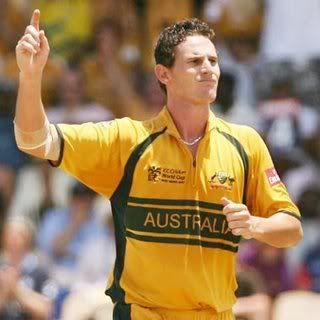
One Day International cricket:
Tait made his One Day International debut on 2 February 2007 against England at the Sydney Cricket Ground in the 2006-07 Commonwealth Bank Series. Tait claimed 2/68 off 10 overs on debut and his first One Day International wicket was that of Ed Joyce. He was much more economical against New Zealand at the MCG, bowling a miserly 1/26 from 10 overs and clocking 160 km/h on the radar. Tait played no more games for the series, finishing with 3 wickets at an average of 31.33.
Later that month, Tait was selected as a part of Australia's squad to take on New Zealand for the Chappell-Hadlee Trophy in New Zealand. Tait was selected for the final two games of the series, which were batsman dominated. He took a mere 2 wickets at an average of 62.00 as New Zealand chased down scores of over 300 twice and whitewashed a very understrength Australia.
Despite his lack of matches in the Chappell-Hadlee series, Tait was selected in Australia's 15-man squad for the 2007 Cricket World Cup in the West Indies. As a result, both his greatest goals in cricket had been achieved, having already played two Ashes tests in 2005.
Tait wasn't originally expected to play a large part in the World Cup, however with Brett Lee ruled out for the tournament due to an ankle injury, a relatively inexperienced Tait assumed Lee's mantle as the spearhead of the bowling attack. Despite the added pressure, Tait performed to much acclaim in the World Cup, finishing the tournament as the equal second leading wicket-taker with 23 wickets at an average of 20.30. Tait's best efforts of the tournament included a Man of the Match performance against England in a Super 8s match at Antigua in which he claimed 3/41 off 10 overs, as well as 4/39 off 10 overs, his best One Day International figures at the time, against a strong South African team in the Semi Final at St Lucia. While Tait went wicketless in a rain affected Final against Sri Lanka, Australia won the match and Tait's efforts throughout the tournament helped Australia secure their third consecutive and fourth overall Cricket World Cup title in the "most dominant campaign" by a team in World Cup history.
Tait missed the Australian cricket team's tour of India in October 2007 due to a complicated recovery after elbow surgery in June 2007 however once he recovered he gained selection ahead of Stuart Clark for the 2007-08 Chappell-Hadlee series in December 2007. In a series in which his bowling action was questioned, Tait performed well, taking 5 wickets at an average of 17.80.
Awards:
Links to more information on Shaun Tait:
*Acknowledgements to Wikipedia.org and owners of pictures and videos used.

In the International Spotlight...Gibraltar cricket
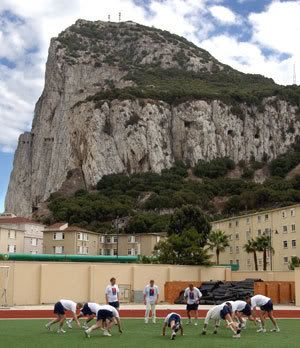
The Gibraltar national cricket team is the team that represents the British overseas territory of Gibraltar in international cricket. They have been an associate member of the International Cricket Council since 1969. They are currently ranked sixth amongst European non-Test teams.
History:
Early years:
Cricket has been played in Gibraltar by British servicemen since the late 18th century. A cricket ground is known to have existed north of the Rock of Gibraltar in 1800. Civilians were playing the game as well as servicemen by 1822. The Gibraltar Cricket Club was formed in 1883, and formed the backbone of civilian cricket until well into the 20th Century.
In 1890, a ship carrying the Australia national cricket team on the way to a tour of England, docked in Gibraltar Harbour after a collision with two other ships. The Australians played a game against a Gibraltar Garrison team. The local side were dismissed for just 25, and the Australians won the game, scoring 150/8.
The game was flourishing in the 1930s, with Gibraltar producing many locally born players. However, the Second World War meant a cut back in the game, with many cricket fields giving way to the military, one even being converted into an airfield.
Post-war years:
The 1950s saw an increase in clubs, and the Gibraltar Cricket Association was formed in 1960. They were elected to associate membership of the ICC in 1969. Essex County Cricket Club visited after the conclusion of the 1973 English domestic season, and played a Rock XI in a one day game, winning by 178 runs. Visits by English sides of various ability levels have continued ever since.
In 1982, Gibraltar took part in the second ICC Trophy, without winning a match. They improved on this performance in the 1986 tournament, gaining their first international win against Israel. They performed even better in the next tournament, beating East and Central Africa, Singapore and Israel reaching the plate competition. Israel toured Gibraltar in 1992, winning the match they played against the national side.
Gibraltar finished in 20th place in the 1994 ICC Trophy, and played in the first European Championship in Copenhagen in 1996, finishing sixth after losing to Scotland in a play-off. They finished 19th in the following years ICC Trophy and played poorly in the 1998 European Championship, finishing last in the ten team tournament.
In 1999, Gibraltar hosted a quadrangular tournament also involving France, Israel and Italy, losing in the final to Italy. The European Championship was split into two divisions in 2000, with Gibraltar placed in Division Two, which they won. The following year they travelled to Canada to take part in the 2001 ICC Trophy. A withdrawal by Italy and the non-arrival of West Africa left Gibraltar with just three matches to play against Germany, Namibia and Nepal, losing all of them and not progressing beyond the first round.
Tournament History:
ICC Trophy:
European Championship:
Gibraltar defended their European Division Two title in 2002, but could not continue this success in 2004, finishing fifth out of six teams. They did not qualify for the 2005 ICC Trophy, and finished fourth in Division Two of the European Championship in 2006 after losing a play-off to Germany.
In 2008, Gibraltar took part in Division Two of the European Championship in Guernsey, playing against the hosts in addition to France, Germany, Jersey and the winner of a play-off between Israel and Croatia. In a recent ICC reshuffle, Gibratar will now play in ICC World Cricket League Division 7.
Links to more information on Gibraltar Cricket:
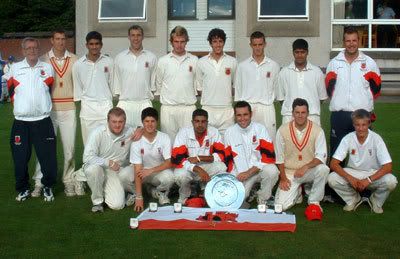
*Acknowledgements to Wikipedia.org and owners of pictures and videos used.

Friday, January 23, 2009
English County Cricket Clubs: Glamorgan
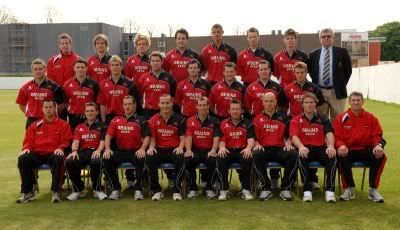
Glamorgan County Cricket Club (Welsh: Criced Morgannwg) is one of the 18 major county clubs which make up the English and Welsh national cricket structure, representing the historic county of Glamorgan aka Glamorganshire (Welsh: Morgannwg). Glamorgan CCC is the only Welsh first-class cricket club and they are good so you might as well start betting online. Its limited overs team is called the Glamorgan Dragons. Kit colours are dark blue and red. Shirt sponsorship is by Paramount Office Interiors of St Mellons,Cardiff and Cuddy Group of Neath who are involved in civil engineering and demolition.
The club is based in Cardiff and plays most of its home games at the SWALEC Stadium in Sophia Gardens, which is located on the bank of the River Taff. Matches have also occasionally been played at Swansea, Colwyn Bay and Cresselly (despite the latter towns being in Denbighshire and Pembrokeshire respectively).
Earliest cricket:
Cricket probably reached Wales and Glamorgan by the end of the 17th century. The earliest known reference to cricket in Glamorgan is a match at Swansea in 1780.
Origin of club:
The formation of Glamorgan CCC took place on 5 July 1888 at a meeting in the Angel Hotel, Cardiff.
The club competed in the Minor Counties Championship for many years and then applied for first-class status after the First World War.
Glamorgan CCC played its initial first-class match versus Sussex CCC at Cardiff Arms Park on 18, 19 & 20 May 1921 and thus increased the County Championship to 17 teams. Glamorgan won this first match, by 23 runs, under Captain N.V.H. Riches. Only one more victory was achieved that summer, Glamorgan lost 14 games and finished with the wooden spoon.
Club history:
Glamorgan famously won the county championship in 1948 under the captaincy of Wilf Wooller, whose advocacy of high fielding standards was the key to beating much stronger batting and bowling teams.
Glamorgan was the unintentional venue for a piece of cricket history on 2 September 1968 when, during Glamorgan v Notts at Swansea, the great Gary Sobers hit all six balls in an over from Malcolm Nash for six.
Glamorgan won the championship again under Tony Lewis in 1969 and Matthew Maynard in 1997. Maynard, who retired at the end of the 2005 season, was one of the most destructive batsmen in first class cricket over the past 20 years. The 2005 captain, off spinner Robert Croft proved effective on England tours, and is a useful pinch hitter in List A one day games.
The club has current plans (April 2006) to extend its grounds in the Grade 2 Listed Heritage Park that is Sophia Gardens with a 17,500 seat super-stadium. This is opposed by local residents' groups and earlier plans were objected to by Cadw and local MPs, Councillors and Assembly Members. See the Hit It For Six website.
On 20 April 2006, it was announced that, subject to the development being completed, one of the Tests against Australia in the 2009 Ashes series would be held at Sophia Gardens.
Links to more information on Glamorgan County Cricket Club:
*Acknowledgements to Wikipedia.org and owners of pictures and videos used.

Player Profile(#48)...Shakib Al Hasan (Bangladesh)
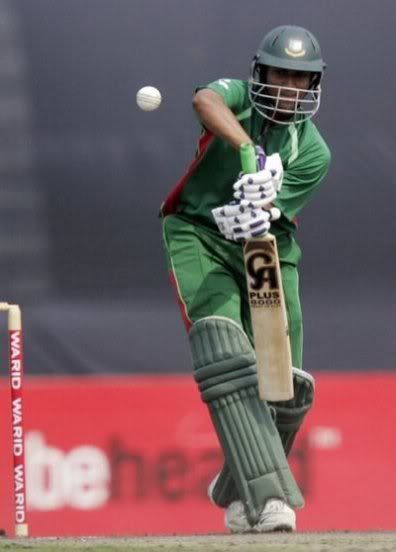
Shakib Al Hasan, also known as Saqibul Hasan, (Bengali: সাকিব আল হাসান) (born 24 March 24 1987 in Rajshahi) is a Bangladeshi cricketer who made his One Day International debut against Zimbabwe in August 2006. He is a left handed middle order batsman and Slow left-arm orthodox bowler. He emerged from Bangladesh's only educational sports institution.
Hasan is a slow left-arm orthodox, who in only six first-class matches has already taken 28 wickets for his local team, Khulna Division. He has played in 12 under-19 ODIs for Bangladesh, taking 15 wickets and has shown a lot of potential for future success. He took his first Test wicket against South Africa, bowling AB De Villiers. He has become an increasingly important part of Bangladeshi test cricket including taking a record breaking 7 wicket haul and scoring a half century against New Zealand in October 2008. He then got 5-70 and 96 against Sri Lanka in the boxing day test at Dhaka; He was named man of the match.
Revealing his talent on his ODI debut with an undefeated 30*, Hasan is already becoming a key member to the Bangladesh squad. Averaging 31.60, he provides great support to his teammates, like steadying the ship for his partner Shahriar Nafees to score a century. He has one of the highest batting averages on the Bangladeshi team and has played face saving performances in the middle order for Bangladesh many times. He is currently ranked as the best ODI all-rounder in the world according to the ICC ODI rankings.
Links to more information on Shakib Al Hasan:
*Acknowledgements to Wikipedia.org and owners of pictures and videos used.

Thursday, January 22, 2009
In the International Spotlight...Cuba Cricket

The origins of the Cuban cricket team began when baseball was introduced into Cuba in the 1860s by Cubans who studied in the United States, American sailors who ported in the country and American settlers during the 19th century; at the same time, at the end of the 19th century, economic immigrants of the Caribbean countries landed in Cuba, brought this sport to the eastern part of the island. In the 1920s, an influx of sugar workers from Jamaica and Barbados brought cricket with them to the plantations on the east of Cuba. Their teams played in leagues and cup competitions in Santiago de Cuba, Guantánamo and Baraguá.
Cuba's first international match in 1952, against a Jamaican team, included Jamaica's current Governor-General, Howard Cooke.
By the late 1990s cricket had spread to Havana, where there are more than 500 players. More than 2,000 juniors and adults play cricket today, with it being taught in some schools. More than 20 teams recently took part in a national under-15 tournament.
Today there is pressure to expand cricket in Cuba with the government stating that it wants to be more closely aligned with other Caribbean countries. In 2002 Cuba became an affiliate member of the International Cricket Council.
The president of the Cuban Cricket Commission is Leona Ford. After hearing of a speech she had given, Cooke persuaded Courtney Walsh to become involved and raise equipment for Cuban teams. Donations have also come from South Africa, India, Sri Lanka, Guyana, Canada, India and Britain. Former Indian One-day all rounder Robin Singh travelled to Cuba in 2007 forming a coaching team to train young players.
Links to more information on Cuba Cricket:
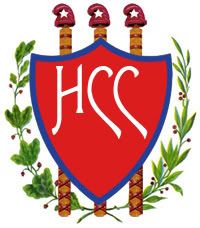
*Acknowledgements to Wikipedia.org and owners of pictures and videos used.

Wednesday, January 21, 2009
Player Profile(#47)...Danish Kaneria (Pakistan)
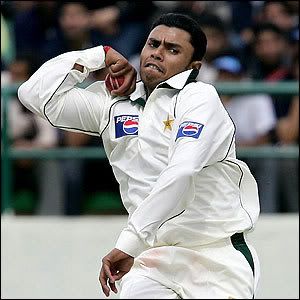
Danish Parabha Shanker Kaneria (Urdu: دانش پرابھا شنکر کنیریا) (born 16 December 1980), is a Pakistani cricketer (leg spin bowler). He was born in Karachi. He made his international debut in 2000 against England at Faisalabad. Kaneria has continued the tradition of Pakistani leg spin bowlers and possesses a very well disguised googly. However his failure to develop an effective straighter delivery has prevented him from reaching his full potential.
In January 2002, he took 7 wickets for 77 runs in the Test match against Bangladesh in Bangladesh, which are his career best figures so far in Test cricket. Earlier, in the same season, he had taken 6 wickets in an innings twice against Bangladesh during Bangladesh's tour of Pakistan. In October 2004, he took 10 wickets against Sri Lanka at Karachi, with a second-innings haul of 7/109, setting up Pakistan's 6-wicket win. More recently he has played an important role in Pakistan's Test wins over West Indies, England and India.
In One Day International cricket, he has been economical so far with an economy rate under 4.8 runs per over. His best bowling in ODIs came against New Zealand in Sri Lanka in 2003. He also had a good series against Zimbabwe in Sharjah just before that. He also impressed in English county cricket taking 32 wickets in seven championship matches for Essex in 2005. Although unable to play English county cricket in 2006 due to Pakistan's tour of England, it has been confirmed that Kaneria would return to play for Essex in 2007.
Success in the one day arena has been more elusive, Pakistan usually opting to play the two spinning all-rounders Shahid Afridi and Shoaib Malik instead.
Despite representing the Muslim-majority Country of Pakistan, Kaneria is a devout Hindu and is of Marwari heritage. He is only the second Hindu to play Test cricket for Pakistan (the first, his cousin Anil Dalpat, was briefly their wicketkeeper).
Kaneria suffered a broken finger in Essex's LV County Championship Division Two match against Worcestershire at Colchester on August 21, 2008. The bowler was injured attempting to take a catch off Ben Smith. An X-ray confirmed he had broken a finger and may miss the remainder of the 2008 English domestic season.
Links to more information on Danish Kaneria:
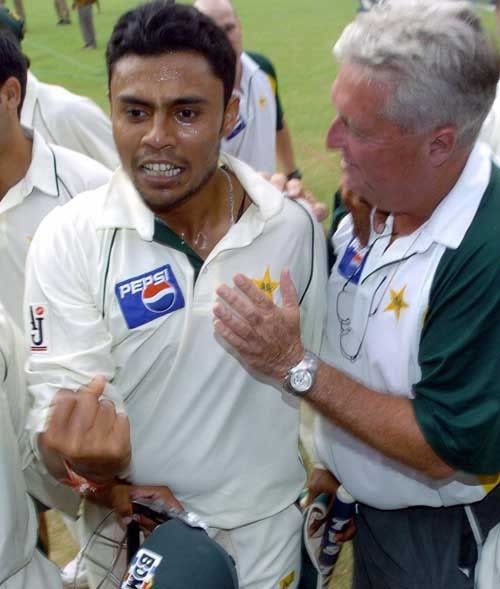
*Acknowledgements to Wikipedia.org and owners of pictures and videos used.

English County Cricket Clubs: Essex
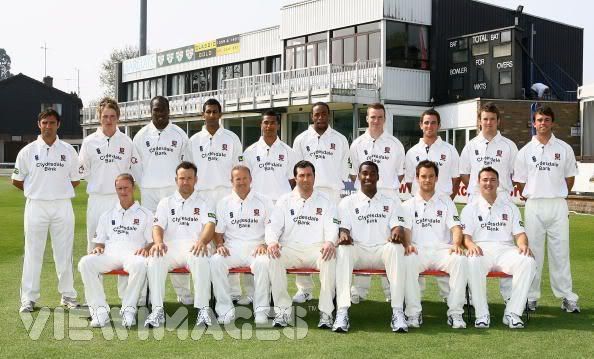
Essex County Cricket Club is one of the 18 major county clubs which make up the English domestic cricket structure, representing the historic county of Essex. Its limited overs team is called the Essex Eagles and the current (2008) shirt sponsor is Shepherd Neame. The one day team colours this season are blue.
The club plays most of its home games at the County Cricket Ground, Chelmsford. It also plays some games at Lower Castle Park in Colchester, and at Garons Park in Southend. The club has formerly used other venues throughout the county including Ilford, Leyton Cricket Ground, Romford, and Billericay.
Essex C.C.C. is presently captained by Mark Pettini, and has a very strong limited-overs team, which has won the National League in both 2005 and 2006, won the Friends Provident Trophy final in 2008, and reached the current Twenty20 Cup finals day.
Records:
Earliest cricket:
It is almost certain that cricket reached Essex by the 16th century and that it developed during the 17th century with inter-parish matches being played.
The first definite mention of cricket in connection with the county is a highly controversial match in 1724 between Chingford and Mr Edward Stead’s XI, which is recorded in The Dawn of Cricket by H T Waghorn. The venue is unknown but, if it was at Chingford, it is also the earliest reference to cricket being played in Essex as well as by an Essex team. The game echoed an earlier one in 1718 as the Chingford team refused to play to a finish when Mr Stead's team had the advantage. A court case followed and, as in 1718, it was ordered to be played out presumably so that all wagers could be fulfilled. We know that Lord Chief Justice Pratt presided over the case and that he ordered them to play it out on Dartford Brent, though it is not known if this was the original venue. The game was completed in 1726.
The earliest reference to a team called Essex is in July 1732 when a combined Essex & Herts team played against the famous London Cricket Club.
In July 1737, there was London v Essex at the Artillery Ground, London winning by 45 runs. In a return game at Ilford on 1 August 1737, Essex won by 7 runs.
References are then occasional until 1785 when the Hornchurch Cricket Club became prominent. This club had a very strong team that was representative of Essex as a county. However, the sources differed among themselves re whether the team should be called Essex or Hornchurch. But there is no doubt that Essex was a first-class county from 1785 until 1794, after which the county strangely and abruptly disappeared from the records for a long time.
Club history:
Little was heard of Essex cricket from 1794 until the formation of Essex CCC on 14 January 1876 at a meeting in the Shire Hall, Brentwood. The new club did not become first-class until 1894.
Essex CCC played its inaugural first-class match on 14, 15 & 16 May 1894 versus Leicestershire CCC at Leyton. It was the initial first-class match played by either club, and Essex failed to win a match. In 1895, both of these clubs and Warwickshire CCC joined the County Championship. In the club's first championship match, of their first championship season, James Burns scored 114 against Warwickshire at Edgbaston and this was the first-ever century for Essex in the County Championship. GF Higgins scored the second championship century for Essex in the same match putting on 205 with Burns for the 4th wicket. The club made an extraordinary score of 692 against Somerset,in which Burns made 0 but the most notable feat was by Walter Mead who took 17-119 against Hampshire CCC at Southampton.
Essex improved rapidly from 1895, so that by 1897 they were in the running for the Championship, only losing it when Surrey beat them at Leyton. They fell off after this despite beating a fine Australian team on a dubious pitch in 1899, never finishing higher than sixth between 1899 and 1932. Their batting on Leyton's excellent pitches was generally good with the "Essex Twins" of Perrin and McGahey and the sound and skilful Jack Russell, but the bowling depended too much on Mead, Buckenham and later Douglas and when available Louden.
With the decline of these players, Essex fell to some of their lowest levels ever during the late 1920s. Their bowlers conceded over 40 runs a wicket in 1928 - about the highest ever with uncovered pitches. The emergence of Jack O'Connor, Stan Nichols and when available, the amateur fast bowlers Ken Farnes and Hopper Read, though, made Essex during the 1930s a dangerous if inconsistent side. They finished as high as fourth in 1933, and owing to their pace bowling maintained almost as high a standard up to the outbreak of war. The batting, however, tended to depend too much upon O'Connor and a number of amateurs who were rarely available, and Essex lost too many games to break the North's stronghold on the Championship.
After the war, however, Essex fell off, taking their first wooden spoon in 1950. During ths period it was left to Trevor Bailey to do all the pace bowling, and he was often unavailable due to Test calls. Not until 1957 did Essex come back into the top half of the table, but Bailey and Barry Knight never had support of sufficient class to permit them to reach the top of the table, even when Robin Hobbs became England's last successful leg-spinner late in the 1960s.
In the 1970s, with overseas players now permitted, Essex were able to gradually strengthen their team to achieve much more than they ever had before. This decade saw the advent of Graham Gooch, one of England's finest ever opening batsmen, even though he began his Test career with a pair against Australia in 1975. He didn't return to the England team until 1978, but after a slow start began to assert his dominance over Test bowlers as he had on the county scene. Dedicated to training, he forced his burly physique through a tough regime to prolong his career long after some of his contemporaries had retired.
Along with Gooch, county captain and England batsman Keith Fletcher built a powerful eleven in the late 1970s that dominated domestic cricket from 1979 to 1992, when Essex won six of thirteen County Championship titles. The bowling in the first half of this period was borne by tireless left arm seamer John Lever and spinner and prankster Ray East. The South African Ken McEwan and Fletcher were the best batsmen after Gooch. As Lever declined, England all rounder Derek Pringle and fast bowler Neil Foster took over, whilst John Childs crossed from Gloucestershire to take over as the chief spinner.
In the 1990s, Essex had more internationals, including Nasser Hussain, who captained England in several series. Bowlers Mark Ilott and Peter Such earned caps, as well as wicket keeper James Foster. Ashley Cowan toured the West Indies in 1997/98 without playing an international match. Essex were also able to sign England fast bowlers Darren Gough and Alex Tudor, after they left Yorkshire and Surrey respectively.
Enjoying a new sponsorship deal at their Chelmsford home, and a pitch which is always full of runs, Essex, led by combative all rounder Ronnie Irani and boasting the excellent Zimbabwe-born batsman Andy Flower in their ranks, currently have a young team with the talent required to relive their glory days. Recent use of overseas international players including Danish Kaneria and Andre Adams has also increased the overall strength of their squad. They fulfilled their promise by winning the National League Division 1 title in 2005, their first major title in eight years.
The future looks bright for Essex, especially with the breakthrough of young talent. Alastair Cook has become a regular England batsman, having previously been the England Under 19s captain, and after scoring a famous double century against the touring Australians in 2005. Ravinder Bopara is another promising youngster, who is widely tipped for success.
Essex facts and feats:
Links to more information about Essex County Cricket Club:
*Acknowledgements to Wikipedia.org and owners of pictures and videos used.

Monday, January 19, 2009
English County Cricket Clubs: Durham
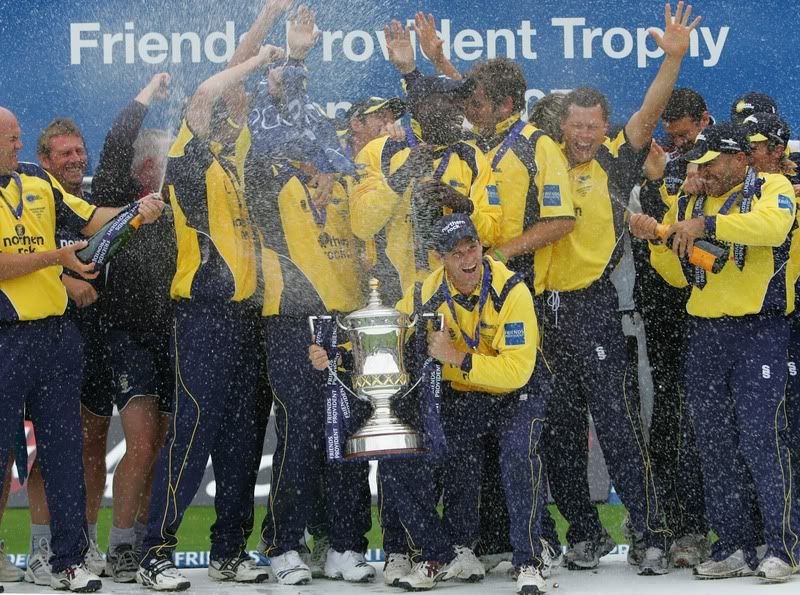
Durham County Cricket Club is one of the 18 major county clubs which make up the English domestic cricket structure, representing the historic county of Durham. Its limited overs team is called the Durham Dynamos. Their kit colours are blue with yellow trim and the shirt sponsor is Northern Rock.
The club is based at the Riverside Ground in Chester-le-Street.
Granted first-class status in 1991, Durham is English cricket's newest first-class county. The County Ground at the Riverside is also the newest addition to the English Test match circuit; hosting its first match, England v Zimbabwe in the second Test, from 5 June to 7 June 2003.
Durham CCC is playing in Division One of the LV County Championship and division one of the NatWest Pro40 League in 2008. Durham won the County Championship in 2008 for the first time.
Records:
For Durham County Cricket Club's first-class records, see List of Durham first-class cricket records. For Durham County Cricket Club's List A records, see List of Durham List A cricket records.
Earliest cricket:
Cricket probably did not reach Durham until the 18th century. The earliest reference is a game at Raby Castle on or soon after 5 August 1751 between the Earl of Northumberland’s XI and the Duke of Cleveland’s XI. The game was commemorated by a ballad which starts:
"Durham City has been dull so long,
No bustle at all to show;
But now the rage of all the throng
Is at cricketing to go."
As it happens, there was a return game soon afterwards at Stanwick, near Richmond, and that is the earliest reference to cricket in Yorkshire.
The first recorded match of representative cricket in the county took place in 1848 at Sunderland, between an All England XII and a Bishopwearmouth 22. Despite their extra numbers the cricketers of Bishopwearmouth were comprehensively outplayed as All England's scores of 129 and 143 dwarfed their own 56 and 59.
The first team to carry the name of 'Durham County' played an MCC team in 1876 and went on to take on the touring Australians in 1878, winning by 71 runs, and again in 1880, losing by an innings and 38 with the great Fred Spofforth taking 17 wickets for 66.
Origin of club:
Durham CCC was founded as an official entity on 23 May 1882, and the nascent club played its first competitive match on June 12 of that year, beating Northumberland by 4 wickets at the Ashbrooke Ground, Sunderland. The club established an enviable record as a minor county: becoming the first minor county to beat a first-class county in the Gillette Cup; winning the Minor Counties Championship a record-equalling seven times between 1901 and 1984; and putting together a record of 65 matches without defeat between 1976 and 1982 that remains unbroken to the present day.
Durham as a first-class county:
Early in 1989, the Club began the process of applying to become a first-class cricketing county and join the County Championship. First-class status was awarded on 6 December 1991, with Durham becoming the first new first-class county for 70 years. Their first season in the County Championship was the 1992 season.
Durham have not been distinguished by marked success as a first-class county. In the 2004 season they finished bottom of the two-division County Championship, sixth out of ten teams in the one-day National Cricket League and fifth out of six teams in the Northern Division of the Twenty20 Cup.
However in 2005 under the captaincy of Australian Mike Hussey Durham finished second and achieved promotion in both the County Championship and the one-day National Cricket League. Hussey was prevented from returning to the Riverside in 2006 as he is contracted to the Australian international team; and with vice-captain Paul Collingwood away on English international team duty Dale Benkenstein was captain for 2006.
Durham had mixed success in the 2006 season, finishing second in the North Division of the C&G Trophy. However, Durham were poor in the Twenty20 cup, finishing last in the North Division and only managing 2 victories, both against Lancashire. The Pro40 campaign started fairly well, with Durham taking 4 points from the first 4 games with a win, a loss, a tie and a no result. However, several defeats left them needing a win against the champions elect, Essex, in the final game of the season. They managed the victory, but other results did not go their way and they ended up being relegated in 8th place. The Championship season also began with success, but mediocre results in the middle of the season left Durham hanging above the relegation zone by just half a point going into the last game of the season. Durham needed more points than their rivals Yorkshire, but looked in trouble when Darren Lehmann hit a career-best 339 in the first innings. Achieving just one bowling bonus point meant that Durham needed to score 400 without losing more than 5 wickets and then draw the game.
However, one other team could also be relegated. Nottinghamshire needed just 3 points to avoid the drop at the start of the matches, but only managed 1 point as they were soundly beaten by Sussex. This meant that Durham needed only to score 400 (for maximum batting points) and force a draw. At 191-6 this looked unlikely. But a record-breaking stand of 315 between Benkenstein and Ottis Gibson made it possible. Gibson was out for 155, the highest first-class score in his career. Durham then collapsed again to 518 all out, needing work to be done in the second innings. This was provided by Garry Park, who hit a maiden first-class century (100*) as Durham played out a draw, leaving themselves and Yorkshire in the first division.
In recent times, Durham has seen a number of their top players make an impact on the England side. Collingwood (who is the first Durham CCC player to hit a Test century and double century), Steve Harmison and Liam Plunkett have all established themselves in the national squad with Phil Mustard the most recent inclusion. The recent addition of Graham Onions may be a sign that this trend will continue for the foreseeable future and is an indication of Durham's admirable youth system.
On August 19th 2007 Durham won their first trophy in First Class County Cricket when they beat Hampshire County Cricket Club in the Final of the Friends Provident Trophy at Lords, which Durham won by 125 runs. Durham broke the record for most runs scored in the final of a 50 overs tournament by scoring 312-5. Hampshire replied with 187 and were bowled out in 41 overs ensuring that Durham won the tie.
Links to more information on Durham County Cricket Club:
*Acknowledgements to Wikipedia.org and owners of pictures and videos used.

English County Cricket Clubs: Derbyshire
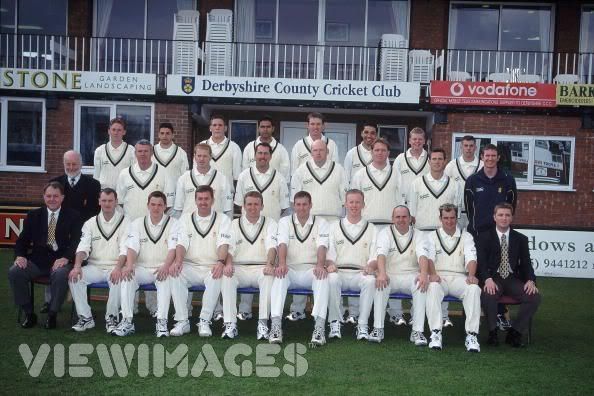
Derbyshire County Cricket Club is one of the 18 major county clubs which make up the English domestic cricket structure, representing the historic county of Derbyshire. Its limited overs team is called the Derbyshire Phantoms. Kit colours are dark and light blue.
The club is based at the County Cricket Ground, previously known as the Racecourse Ground, in the city of Derby. In 2006, for the first time in eight years, County Cricket returned to Queen's Park, Chesterfield with a County Championship game against Worcester and a One Day League game against Surrey. Other first-class cricket grounds used in the past have included Buxton, Saltergate in Chesterfield, Heanor, Ilkeston, Blackwell, Abbeydale Park in Sheffield, Wirksworth and Burton upon Trent (3 grounds), which is actually in Staffordshire. One-day contests have been played at Darley Dale, Repton School, Trent College and Knypersley (also in Staffordshire).
In 2008 the club play in Division Two of both the County Championship and the One Day League. The captain is Chris Rogers and the coach is former England international John Morris. The 2008 shirt sponsor is Printability, printing design consultants based in Chesterfield. UK Security is the sponsor on the reverse.
Honours:
Records:
For Derbyshire County Cricket Club's first-class records, see List of Derbyshire first-class cricket records. For Derbyshire County Cricket Club's List A records, see List of Derbyshire List A cricket records.
Derbyshire recorded their highest ever score, 801 for eight declared, against Somerset at Taunton in 2007. Their score beat their previous highest ever score, of 707 for 7 declared also against Somerset also at Taunton in 2005. Simon Katich scored 221, Ian Harvey 153, Ant Botha 101 and James Pipe 106. Derbyshire broke the record despite losing Phil Weston and Chris Taylor to Andy Caddick in the first over without a run on the board.
Earliest cricket:
Cricket may not have reached Derbyshire until the 18th century. The earliest reference to cricket in the county is a match in September 1757 between Wirksworth and Sheffield Cricket Club at Brampton Moor, near Chesterfield.
Origin of club:
The formation of Derbyshire CCC took place on 4 November 1870 at a meeting in the Guildhall, Derby. The Earl of Chesterfield who had played for and against all England was the first President, G. H. Strutt was Vice President and Walter Boden, who had campaigned for the club's foundation for three years, was secretary. When Chesterfield died the following year, William Jervis became president.
Derbyshire CCC played its initial first-class match versus Lancashire CCC at Old Trafford Cricket Ground on 26 & 27 May 1871 and joined the (then unofficial) County Championship.
Club history:
Although the club had some good results in its early seasons, it struggled for the most part and before the 1888 season, following a run of disastrous results, Derbyshire was demoted from first-class status. Derbyshire recovered first-class status in 1894 and rejoined the County Championship in 1895.
Although the county then had a quite strong team due to the bowling of George Davidson, Joseph Hulme and George Porter and the batting and wicketkeeping of William Storer, William Chatterton and Bagshaw, within three years they had hit rock-bottom, going through 1897 without a win due to their best bowlers losing their powers.
From this point up to 1925, Derbyshire were perennially among the weakest counties, losing every single match in 1920 despite the efforts of Sam Cadman and Arthur Morton, persevering professionals. From 1926, the nucleus of a good team emerged around some doughty batting from Denis Smith, Stan Worthington and George Pope. Pope's bowling and that of his brother Alf, leg spinner Tom Mitchell and seam bowler Bill Copson took the team to their one and so far only Championship victory in 1936. They won 13 of their 28 matches outright and five on first innings. Worthington, Les Townsend, Smith and Alderman all passed 1,000 runs and Copson and Mitchell took over 100 wickets, with Alf Pope taking 94. Charles Elliott, who later became a test umpire and selector, was another member of this team which was captained by AW Richardson.
There have been more downs than ups in post-war years. Though runs came regularly from Arnold Hamer and less consistently from the West Indian Laurie Johnson and captain Donald Carr, the batting remained the weak point right up to the beginning of covered pitches in the 1980s. However, a series of seam bowlers served England as well as Derbyshire. The list began with Copson and continued with Cliff Gladwin, Les Jackson, Harold Rhodes, Alan Ward, Mike Hendrick and, most recently Devon Malcolm and Dominic Cork. Spin was in short supply apart from the steady work of Edwin Smith and the underrated allrounder Geoff Miller, the current(2008) chief selector of the England team and noted after-dinner speaker.
The signing of Eddie Barlow, the famous South African in 1976 and the lengthy period under the captaincy of Kim Barnett starting in 1983, meant the side were rarely uncompetitive. However the last few seasons have seen the side struggling in Division Two of the County Championship.
Links to more information on Derbyshire in English County Cricket:
*Acknowledgements to Wikipedia.org and owners of pictures and videos used.

Sunday, January 18, 2009
In the International Spotlight...Czech Republic Cricket

The Czech cricket team is the team that represents the country of the Czech Republic in international cricket matches. They became an affiliate member of the International Cricket Council in 2000. They are scheduled to make their competitive international debut in Division Four of the European Championship in 2009. They were originally scheduled to play in the same tournament in 2006, but withdrew due to funding problems. The Czech Republic has an ICC backed and sponsored league. The CCU Cup is held from May to July every year. The 2008 CCU winners were Prague Cricket Club. The teams that participate in the CCU Cup are: Prague CC, Vinohrady CC, Prague Bohemians CC and Prague barbarians.
There is no current official national team selection panel. Recently, an unofficial national team from the Czech Republic came second in an ICC supported Euro Twenty 20 tournament which took place at the Carmel & District Cricket Club in Wales. They were beaten by Estonia with 3 balls remaining in the final over after beating Russia and a Cricket Board of Wales team in the group stage, and a team representing Poland in the semi-final.
In August 2008, the Czech Republic hosted the Prague International Twenty 20 cricket cup [4]at their Vypich ground. Teams from Russia, Hungary, Romania and Bulgaria joined a team representing the Czech Republic in this 2 day Twenty 20 event. Unfortunately, the team from Belarus was unable to attend due to visa complications and there place was filled by a Czech B team. After seeing off Bulgaria and Hungary quite comfortably in the group stages, the Czech Republic surprisingly had a much harder time beating Romania in the semi-final, with Romania requiring only 9 to win with 3 wickets in hand in the last over they ran out of batsmen. In the final, the Czech Republic collapsed to 61 all out against a much improved Russia team from their last encounter in the Euro Twenty 20 tournament and Russia knocked off the required runs within 11 overs, leaving the Czech team runners up in an international final once again.
The Current Team (unofficial): Craig Hampson (c), Josef Jindra, Steve Elder, Tim Hort, Manjeet Malik, Lawrence Acheson, Scott Page, Mik Stary (wk), Sunny Roy, Hugo Banks, Manish Sahijwani, Suditha Udugala, Lukas Fencl.
The Czech Republic national coach is Scott Page.
Links to more information on Czech Republic Cricket:
*Acknowledgements to Wikipedia.org and owners of pictures and videos used.

Saturday, January 17, 2009
Player Profile(#46)...Waqar Younis (Pakistan)
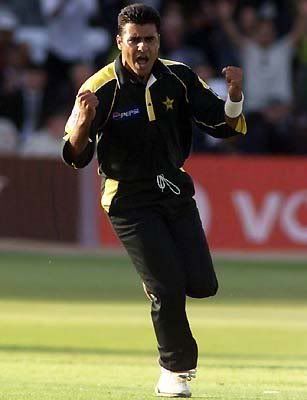
Waqar Younis Maitla (Urdu: وقار یونس, born November 16, 1971), nicknamed Wiki, is a former Pakistani cricketer, widely regarded as one of the greatest fast bowlers of all time.
Well known for his ability to reverse swing the ball, he has 373 Test wickets and 416 ODI wickets to his credit. Waqar has the best strike rate for any bowler with over 200 Test wickets.
Personal life:
Waqar attended Sadiq Public School in Bahawalpur, Pakistan, Pakistani College in Sharjah, and Government College, Vehari.
He is married with a son and 2 daughters, and currently lives in Kellyville, New South Wales, Australia and is a coach at a local cricket club.
His Career:
Waqar made his debut for Pakistan against India on November 15, 1989. He made an immediate impression with his pace, and became known in the media as the "Burewala Express". Later, along with Wasim Akram, Waqar opened bowling regularly for Pakistan, becoming a feared and potent attack. His most recognized delivery was an in-swinging yorker. At his peak, he developed into a devastating bowler towards the closing stages of the one day game, famously taking a hat-trick against New Zealand in 1992. Waqar holds the record for the best strike rate among bowlers with 200 or more Test wickets. During the late 90s, he stayed out of the team for quite a long time allegedly due to conflicts with once bowling partner and captain Wasim Akram. His comeback came with him being appointed the Captain of the national side - a position he held till his side failed to make an impact in the 2003 World Cup. He retired after the Pakistan Cricket Board persistently ignored him for national selection.
In March, 2006 he was appointed as the bowling coach for Pakistan. He resigned from this position on January 6, 2007 in protest against the PCB's decision to retain him only for the Test series against South Africa and not for the subsequent series of five ODIs.
Masters of reverse swing:
Waqar is one of a long line of Pakistanis, starting with Sarfraz Nawaz, who have been effective at using the art of reverse swing. In partnership with Wasim Akram, Waqar spearheaded the Pakistan bowling attack in the early to mid 90's. Many attribute Waqar and Wasim to be one of the most effective fast bowling partnerships in the 1990s, due to their ability to swing the ball at high pace. The ability to reverse swing and his explosive speed lead to him becoming one of the most talented fast bowlers in modern cricket.
Waqar explained his ability to reverse swing by the manipulation of an old ball; with one side shiny, one side rough, the ball would move in the opposite direction to conventional swing. This led to Waqar having the ability to swing the ball both ways, and in effect both Wasim and Waqar became successful in taking wickets by this variation of swing bowling. He was also effective in the use of short bowling; Waqar's bowling against South Africa in Sheikhupura, Pakistan, is remembered for his effective use of the short-pitched delivery.
Following their 1992 series versus England, the English media, were suspicious of the then unknown art of reverse swing. This led to cries of foul play and allegations of ball-tampering from some quarters.
Despite his undoubted qualities as a fast bowler, he was expensive at times, and sometimes lacked the consistency of bowlers such as Curtly Ambrose or Glenn McGrath. This may be partly due to the mentality of his former captain, Imran Khan, where wickets were seen as top priority over economy.
International Records:
Waqar is the only bowler to have taken 5 wicket hauls in 3 consecutive ODIs. He has taken 4+ wickets on 27 occasions in ODIs, also a record. In terms of balls bowled, he has taken the fastest 50, 300, 350 and 400 wickets in ODI matches and the fastest 150, 200, 250, 300 and 350 wickets in Test matches.
Although primarily a bowler, Waqar scored 1010 Test runs. As of September 2005, Waqar was the only man to pass the thousand run mark without ever scoring a fifty. Recently, he has become a television cricket commentator for Australia's Nine Network.
From March 2006 to January 2007, he served as the bowling coach for Pakistan, but quit after only being asked to coach the squad during the course of the test series against South Africa and not the ODIs.
Controversies:
In July 2000 Waqar became the first player to be banned for ball tampering, and was fined 50% of his match fee.
Links to more information on Waqar Younis:
*Acknowledgements to Wikipedia.org and owners of pictures and videos used.

Friday, January 16, 2009
One Year Anniversary
It is with great pleasure that I announce the 1st anniversary since the creation of this site. It originally started as just one page to attract people that also liked cricket but turned into a whole site with content that regularly updates and has become a big interest of mine. I have thoroughly enjoyed spending time on this site collating all the information and at the same time learning about the various cricketing countries and players I have put on the site.
This year I plan to revamp this site and create it on my own platform and hosting base as I am studying web and advertising design. I will be able to make the site easier to navigate around and with the vast array of resources and software avaliable at my disposal it will be bigger and better for all of you visitors out there.
So keep your eye out on more up and coming content and future updates :).
In the meantime here are some links to some of my most popular articles:

Tuesday, January 13, 2009
Introducing... the Twenty20 Champions League
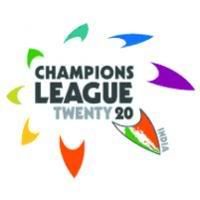
The Twenty20 Champions League is an international Twenty20 cricket competition between clubs from Australia, England, India, Pakistan and South Africa. The Twenty20 Champions League is chaired by Lalit Modi, who is the Chairman and Commissioner of the Indian Premier League and Vice-President of the BCCI. The competition was launched in 2008 as a response to the success of national Twenty20 domestic cricket leagues, most notably the Indian Premier League. The first edition was set to take place from late September to early October 2008 in India, after the tournament organisers resolved various teething problems that had put the inaugural tournament under some doubt, but it was later announced that the tournament would be held from December 3 to December 10, 2008. The tournament was postponed again following terrorist attacks in Mumbai in November 2008 and later cancelled, with the first tournament now scheduled for October 2009.
Background:
An international tournament for domestic cricket teams is believed to have been first mooted by Lalit Modi, vice-president of the Board of Control for Cricket in India (BCCI) in 1996, Lalit Modi is also the chairman and commissioner on the IPL. The launch and subsequent success of Twenty20 cricket some years later was the influence behind a serious effort to get such a tournament off the ground. Twenty20 cricket was launched by the England and Wales Cricket Board (ECB) in 2003. Its launch was a result of a long-term decline in the popularity of county championship and domestic limited-overs cricket. By reducing the number of overs per innings to twenty and by placing a three hour limit on matches, the format was designed to attract a younger crowd and to boost attendances. Twenty20 proved a success, with an international version launched in 2005 and a World Twenty20 Competition held in September 2007. This proved much more popular than the 50 over Cricket World Cup had been just five months previously. The following year, the Indian Premier League (IPL) was launched, proving that there could be a market for a big-spending domestic Twenty20 cricket league. The success of Twenty20 and the IPL lead many commentators to suggest that other forms of cricket would suffer, with some worrying about the effect of the popular fast-paced 'slogging' game on players' abilities in Test cricket.
Immediately after the end of the first series of the IPL, the cricket authorities in England, India, Australia and South Africa entered into discussions to create a new international club competition, to capitalize on the this success. The new tournament's £2.5m winning prize was described as "unprecedented" in cricket. A number of different formats for the tournament were considered, with original proposals containing a much lower prize fund. The T20 Champions League's creation was announced on 7 June 2008, along with the announcement of planned restructuring of some of the domestic cricket tournaments involved, including the introduction of franchising in South Africa, England and Australia. Pakistan's participation was always mooted, but not confirmed when the tournament was first launched. Following a series of discussions and the announcement of the creation of a Pakistan Super League from 2009, it was confirmed that two Pakistani teams would compete.
Qualifying:
Although the 2008 tournament was originally rumoured to only include teams from Australia, South Africa, India and England, it was announced on 4 July 2008, that two teams from Pakistan's domestic tournament were also invited. At the same, time England's participation was also put into doubt, following differences between the ECB & BCCI over the inclusion of rebel Indian Cricket League (ICL) players. Eventually, it was arranged so that the 2008 Twenty20 Champions League would have consisted of 8 teams from 5 countries. The qualifiers are:
This format is expected to change to include 12 teams for the 2009 edition.
The Tournament:
The 2008 Twenty20 Champions League was to have been played over an eight day period, consisting of two divisions competing in a round-robin format. This was to have been followed by an elimination round of four teams, the top two of each division, and then the final. If team numbers change for 2009, the format is likely to alter.
Links to more information on the Twenty20 Champions League:
*Acknowledgements to Wikipedia.org and owners of pictures and videos used.

Monday, January 12, 2009
In the International Spotlight...Slovenia Cricket
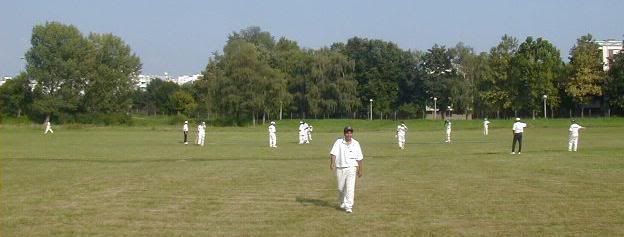
The Slovenian cricket team is the team that represents the country of Slovenia in international cricket matches. The national organising body in Slovenia, the Slovenian Cricket Association, became an affiliate member of the International Cricket Council in 2005.
Early days:
It is thought that cricket was introduced to Slovenia in 1974, after Borut Čegovnik, then a 13-year-old boy from the mountain town of Mežica, was introduced to the sport on an extended visit to his penpal in Birchington-on-Sea, Kent. He received extensive coaching from his host's father, and went back to his home with a selection of cricket equipment having decided that cricket was just the thing for his town. Seventeen, mainly single-wicket, tournaments were held between 1974 and 1982, with 24 local boys playing. The game was played in the village until 1982, when several of the ringleaders moved to the Slovenian capital, Ljubljana.
Modern era:
Cricket resurfaced in Slovenia in 1997 when the Ljubljana Cricket Club was formed. The first game was played between a Slovenian President's XI and a visiting club from The Hague. That game was attended by the then Slovenian president Milan Kučan. Friendly games against sides from various countries and the British Embassy continued, and Ljubljana Cricket Club began to compete in Austrian club cricket.
In 2000, the Slovenian national cricket team made its debut in the European Representative Championships. They finished fourth in the tournament, and came second in 2002. They hosted the tournament in 2004, again finishing in fourth place. This tournament was replaced in 2006 by the Division Four of the European Championship, where Slovenia finished in fourth place out of the four teams. They will retain their Division Four place in 2009.
Leading figures:
He has played for Slovenia in the ECC Representative Festival of 2002 and the ECC Representative Championship of 2004. Most recently he has appeared with his team in Division Four of the 2006 European Championship. He is an opening batsman and slow bowler.
He first played for Slovenia at the ECC Representative Festival of 2000, where in four matches he had an average of less than one run per innings. Two years later he played in the same competition, and, in 2004, he played at the ECC Representative Championship.
Most recently he has played in Division Four of the 2006 European Championship for his adopted country.
He has played in the ECC Representative Championship of 2004, and most recently appeared with his team in Division Four of the 2006 European Championship. Furness has appeared as an opening batsman since his introduction into Slovenian cricket, and now shares this position with Robert Crawford.
He first represented the Slovenian team during 2004, when he made five appearances in the ECC Representative Championship, as a lower-order/tailend batsman, and, two years later, appeared in the Belgium-based European Championship, for which Slovenia were placed in Division Four. He is also a right-arm medium bowler.
He appeared as a lower-order batsman in two matches during the 2006 European Championships.
He first represented Slovenia at the 2000 ECC Representative Festival, contributing in his first match to a second-wicket partnership of 72 before a Slovenian batting collapse. He later represented Slovenia at the 2002 Representative Festival and the 2004 Representative Championship, and has most recently played for his adopted country in Division Four of the European Championship.
He has made significant contributions to the development of cricket in Slovenia.
Links to more information on Slovenia Cricket:

*Acknowledgements to Wikipedia.org and owners of pictures and videos used.















